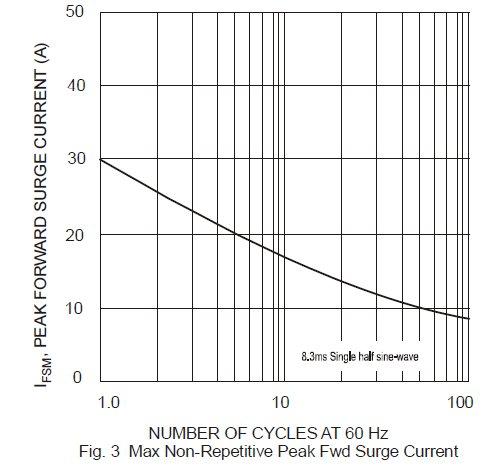This will only be of interest to (some) ‘techies’.
In another thread ( click here ) ...
Turning to technicalities ... as for the maximum peak current being time-limited, that's true, but that current limit rapidly falls when the over-current is frequently repeated, as obviously is the case with AC applications). If you consider the ubiquitous IN400x diodes, they are rated for a maximum continuous rectified current of 1A, but a 'non-repetitive peak forward current' (one half cycle of 60Hz size wave, approx 8.3mS) of 30A. However, when that half cycle is constantly repeated, the maximum permissible peak current rapidly falls:
As you can see, after just 100 cycles of 60 Hz (less than two seconds), the peak permissible current has fallen from 30A to about 8A (corresponding to ~5.6A RMS), so goodness knows how low it gets with continuous AC.
Kind Regards, John
In another thread ( click here ) ...
Yes, I agree with that, but I'm not really sure what/why we are arguing about. As I said, the use of a diode bridge to achieve supply polarity independence for DC equipment is very well established, and I have used in countless times (for currents varying from trivial to very large) over the years/decades. All that matters is to make sure that the diodes can cope (at operating temperature) with the DC currents involved - not a problem with present-day components. Nor did I necessarily mean custom-made 'bridge rectifiers'; on the contrary, I've usually used discrete diodes for this purpose.Peak currents are time limited, the thermal mass of the diode determines how much peak current can flow and for how long before the diode overheats to the point of destruction. A bridge rectifier rectifying AC will be dissipating the heat from 4 diodes. When the same bridge rectifier is used with a DC supply only two diodes are dissipating the same amount of heat that 4 would be when the supply is AC. Running on DC the maximum safe continuous current may be less than the maximum safe continuous current for AC. The derating for use on DC depends on the construction and method of heat disipation inside the bridge rectifier
Turning to technicalities ... as for the maximum peak current being time-limited, that's true, but that current limit rapidly falls when the over-current is frequently repeated, as obviously is the case with AC applications). If you consider the ubiquitous IN400x diodes, they are rated for a maximum continuous rectified current of 1A, but a 'non-repetitive peak forward current' (one half cycle of 60Hz size wave, approx 8.3mS) of 30A. However, when that half cycle is constantly repeated, the maximum permissible peak current rapidly falls:
As you can see, after just 100 cycles of 60 Hz (less than two seconds), the peak permissible current has fallen from 30A to about 8A (corresponding to ~5.6A RMS), so goodness knows how low it gets with continuous AC.
Kind Regards, John


